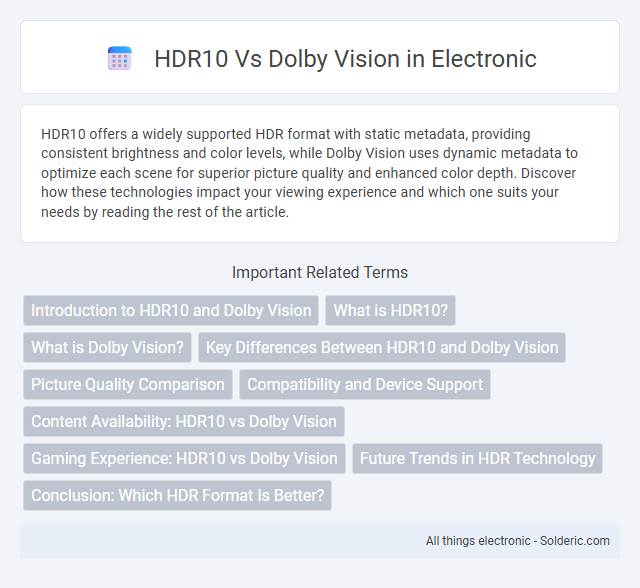HDR10 offers a widely supported HDR format with static metadata, providing consistent brightness and color levels, while Dolby Vision uses dynamic metadata to optimize each scene for superior picture quality and enhanced color depth. Discover how these technologies impact your viewing experience and which one suits your needs by reading the rest of the article.
Comparison Table
| Feature | HDR10 | Dolby Vision |
|---|---|---|
| Dynamic Metadata | No (Static Metadata) | Yes (Dynamic Metadata) |
| Peak Brightness | Up to 1,000 nits | Up to 10,000 nits |
| Color Depth | 10-bit | 12-bit |
| Color Gamut | BT.2020 | BT.2020 |
| Content Compatibility | Widely supported | Less widespread, growing support |
| Licensing | Open standard, free | Proprietary, requires license |
| Use Cases | Standard HDR on Blu-ray, streaming | Premium UHD streaming, Blu-ray, Cinematic |
Introduction to HDR10 and Dolby Vision
HDR10 is a widely adopted open standard for high dynamic range video that supports 10-bit color depth and static metadata, enhancing contrast and color accuracy for compatible displays. Dolby Vision offers a dynamic metadata-driven HDR format that delivers superior picture quality by adjusting brightness and color on a scene-by-scene or frame-by-frame basis with support for up to 12-bit color depth. Both technologies aim to improve visual experience on HDR-capable TVs, but Dolby Vision provides more precise and dynamic image optimization.
What is HDR10?
HDR10 is an open standard for high dynamic range video, widely supported across various streaming platforms and TVs. It uses static metadata to optimize brightness, contrast, and color for the entire content, ensuring compatibility with most HDR-enabled devices. Understanding HDR10 helps you enhance your viewing experience with richer visuals and more lifelike images.
What is Dolby Vision?
Dolby Vision is an advanced HDR (High Dynamic Range) format that enhances video quality by delivering greater brightness, contrast, and a wider color gamut compared to HDR10. It uses dynamic metadata to adjust tone mapping on a scene-by-scene or frame-by-frame basis, ensuring optimal picture quality on compatible TVs and devices. You can experience more vivid colors and deeper blacks with Dolby Vision, making it a premium choice for cinematic viewing.
Key Differences Between HDR10 and Dolby Vision
HDR10 uses static metadata to apply a single tone-mapping curve for the entire content, while Dolby Vision employs dynamic metadata for scene-by-scene adjustments, resulting in more precise brightness and color accuracy. HDR10 supports up to 10-bit color depth and a peak brightness of 1,000 nits, whereas Dolby Vision can handle up to 12-bit color depth and peak luminance levels exceeding 4,000 nits, enhancing detail in both dark and bright scenes. Dolby Vision also requires licensing fees and compatible hardware, whereas HDR10 is an open standard widely supported across platforms and devices.
Picture Quality Comparison
Dolby Vision offers superior picture quality compared to HDR10 due to its dynamic metadata, which adjusts brightness and color on a scene-by-scene basis, enhancing contrast and color accuracy. HDR10 uses static metadata, resulting in a fixed luminance level that may not optimize all scenes equally. Dolby Vision supports up to 12-bit color depth and higher peak brightness, delivering more vivid and lifelike images than HDR10's 10-bit color and peak brightness limitations.
Compatibility and Device Support
HDR10 enjoys widespread compatibility, supporting most modern 4K TVs, streaming devices, and gaming consoles due to its open standard nature. Dolby Vision requires specific hardware and licensing, limiting its support primarily to premium TVs, certain streaming services, and select devices like Apple TV 4K and Xbox Series X. Consumers should consider their existing device ecosystem and content sources when choosing between the two HDR formats for optimal viewing experience.
Content Availability: HDR10 vs Dolby Vision
HDR10 content is widely available across streaming platforms, UHD Blu-rays, and gaming consoles due to its open standard status, making it the most common HDR format supported by the majority of devices. Dolby Vision, while offering dynamic metadata for enhanced picture quality, has more limited content availability but is steadily increasing on platforms like Netflix, Disney+, and Apple TV+. Content creators prefer Dolby Vision for its superior color grading capabilities, yet HDR10 remains the more prevalent choice for compatibility and widespread distribution.
Gaming Experience: HDR10 vs Dolby Vision
Dolby Vision enhances gaming with dynamic metadata that adjusts HDR brightness and contrast scene-by-scene, delivering more vivid visuals and improved color accuracy compared to HDR10's static metadata. HDR10 offers broad compatibility and solid performance, but its fixed HDR settings may miss subtle detail variations during fast-paced gameplay. Gamers equipped with Dolby Vision-capable displays and consoles benefit from superior image depth and brightness, creating a more immersive and responsive gaming experience.
Future Trends in HDR Technology
HDR10 remains the industry standard for HDR content with broad device compatibility and open-source accessibility, while Dolby Vision offers dynamic metadata for superior picture quality and adaptive display optimization. Future trends in HDR technology point toward increased adoption of Dolby Vision HDR in streaming platforms and next-generation TVs, driven by enhanced color depth and luminance capabilities. Your viewing experience will benefit from advancements in HDR standards that deliver more vivid and lifelike images through real-time scene-by-scene adjustments.
Conclusion: Which HDR Format Is Better?
Dolby Vision offers dynamic metadata, delivering scene-by-scene optimization for superior color accuracy and contrast compared to HDR10's static metadata. Your viewing experience benefits most from Dolby Vision's higher peak brightness and 12-bit color depth support, which enhances detail in both dark and bright scenes. HDR10 remains widely compatible and more accessible, but for cutting-edge HDR performance, Dolby Vision is the better format.
HDR10 vs Dolby Vision Infographic

 solderic.com
solderic.com